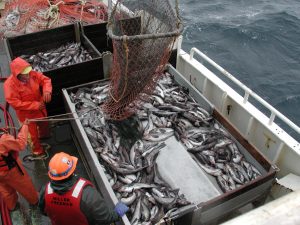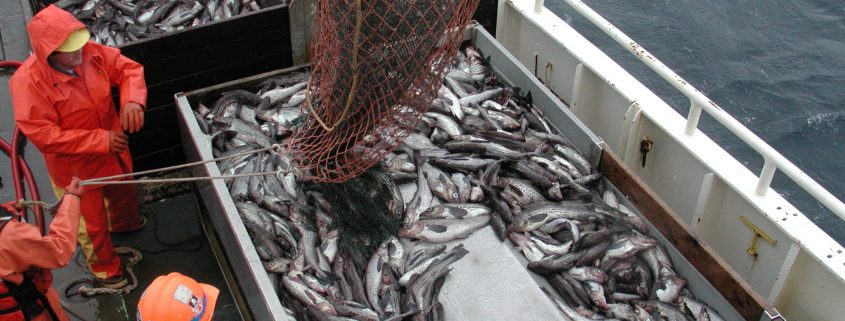Marine Protected Area Connectivity
by Hannah Armstrong, RJD Intern
More than 25% of the world’s fishery populations are considered overexploited or depleted, and 40% are heavily to fully exploited (Dayton PK, Sala E, Tegner MJ, Thrush S). In fact, some marine organisms have been driven extinct by human activity, while others remain close to extinction (Dayton PK, Sala E, Tegner MJ, Thrush S). In addition to other approaches, marine-protected-area design and implementation is an evolving tool to help conserve and manage these depleting fisheries. They are not only important for biodiversity conservation, but also as management and learning tools (Pujola JM, Schiavina M, Di Franco A, Melia P, Guidetti P, Gatto M, De Leo GA, Zane L.). Networks of marine protected areas, which differ in shape and size, help scientists evaluate theories of optimal shape and size for proper management and design, ultimately leading to adaptive management strategies (Pujola JM, Schiavina M, Di Franco A, Melia P, Guidetti P, Gatto M, De Leo GA, Zane L.). The effectiveness of marine protected areas, as well as the importance of marine protected area connectivity, however, does not seem to be fully understood.
Protected areas are becoming ever more critical in marine habitats, especially with increasing threats of overfishing, pollution and coastal development. When it comes to the design of marine protected areas and marine reserves, it is imperative that scientists and researchers consider patterns of connectivity. Marine connectivity is the bridge between marine habitats, occurring via larval dispersal as well as by the movements of adults and juvenile marine species; it is an important part of ensuring larval exchange and the replenishment of biodiversity in areas damaged by natural or human-related agents (McLeod E, Salm R, Green A, Almany Jeanine). Studies have shown that surface currents typically define dispersal patterns, but not all distribution is explained by passive drift alone; some migrations cause larvae to be transported in one direction by surface currents, and in another direction many hours later by subsurface currents (Dayton PK, Sala E, Tegner MJ, Thrush S). It is critical to study the connectivity caused by different marine organism behaviors and transport processes to ensure optimal conservation.
According to the IUCN, a marine protected network is a “collection of individual MPAs operating cooperatively and synergistically, at various spatial scales, and with a range of protection levels, in order to fulfill ecological aims more effectively and comprehensively than individual sites could alone” (McLeod E, Salm R, Green A, Almany Jeanine). The consideration of connectivity in marine protected area network design allows critical areas to be protected. Critical areas include nursery grounds, fish spawning aggregation sites, regions that feature high species diversity or high rates of endemism (habitat-specific), and areas that contain a variety of habitat types in close proximity to one another (McLeod E, Salm R, Green A, Almany Jeanine).

In order to maintain ecosystem function, critical areas, such as fish spawning aggregation sites, need to be protected in marine protected areas.
(source: McLeod E, Salm R, Green A, Almany Jeanine. Designing marine protected area networks to address the impacts of climate change. Frontiers in Ecology and the Environment 7 (2009).)
In recent scenarios in which climate change has become a notable issue, it is also essential to protect areas that may be naturally more resistant or resilient to the threats associated with climate change (ie: coral bleaching) (McLeod E, Salm R, Green A, Almany Jeanine). Moreover, the potential for MPAs to change population sustainability, fishery yield, and ecosystem properties depends on the poorly understood consequences of three critical forms of connectivity over space: larval dispersal, juvenile and adult swimming, and movement of fishermen (Botsford LW, Brumbaugh DR, Grimes C, Kellner JB, Largier J, O’Farrell MR, Ralston S, Soulanille E, Wespestad V). Without taking into account these factors, connectivity amongst marine protected areas or networks is not possible.

Overfishing has caused fisheries to be exploited or in some cases overexploited, making marine protected areas a much more critical tool in marine conservation.
(source: wikimedia commons http://commons.wikimedia.org/wiki/File:Theragra_chalcogramma_fishing.jpg)
Still, it is only once scientists and MPA implementers fully understand connectivity patterns that proper conservation techniques and MPA management can occur. Some data shows that a variety of marine species indicate that larval movements of 50-100km appear common for marine invertebrates, and from 100-200km for fishes (McLeod E, Salm R, Green A, Almany Jeanine). Some researchers believe that a system-wide approach should be adopted that addresses patterns of connectivity between ecosystems like mangroves, reefs, and sea grass beds to enhance resilience (McLeod E, Salm R, Green A, Almany Jeanine). If there is connectivity between linked habitats, then ecosystems can continue to function properly, or in some cases, recover from their depleted states. Those designing marine protected networks can use this data to determine the appropriate size of the reserve being implemented, allowing them to ensure larval connectivity.
Networks of marine reserves have become key tools in the effort to conserve our world’s oceans and the species therein. Future selection of marine protected areas and networks will depend on both the connectivity of targeted species, as well as the habitat quality of individual sites (Berglund M, Jacobi MN, Jonsson PR). Though there are opposing opinions regarding the most effective methods of marine biodiversity conservation, as well as with regard to the specific locations, sizes, and connectivity of marine reserves (Sala E, Aburto-Oropeza O, Paredes G, Parra I, Barrera JC, Dayton PK), there are growing research efforts to ensure successful conservation and management.
REFERENCES
1.Christie MR, Tissot BN, Albins MA, Beets JP, Jia Y, et al. Larval Connectivity in an Effective Network of Marine Protected Areas. Plos One 5 (12) (2010).
2. Botsford LW, Brumbaugh DR, Grimes C, Kellner JB, Largier J, O’Farrell MR, Ralston S, Soulanille E, Wespestad V. Connectivity, sustainability, and yield: briding the gap between conventional fisheries management and marine protected areas. Reviews in Fish Biology and Fisheries 19 (1) (2009).
3. Planes S, Jones GP, Thorrold SR. Larval dispersal connects fish populations in a network of marine protected areas. PNAS 106 (14) (2009).
4. Sala E, Aburto-Oropeza O, Paredes G, Parra I, Barrera JC, Dayton PK. A General Model for Designing Networks of Marine Reserves. Science 298 (5600) (2002).
5. Berglund M, Jacobi MN, Jonsson PR. Optimal selection of marine protected areas based on connectivity and habitat quality. Ecological Modeling 240 (2012).
6. McLeod E, Salm R, Green A, Almany Jeanine. Designing marine protected area networks to address the impacts of climate change. Frontiers in Ecology and the Environment 7 (2009).
7. Pujola JM, Schiavina M, Di Franco A, Melia P, Guidetti P, Gatto M, De Leo GA, Zane L. Understanding the effectiveness of marine protected areas using genetic connectivity patterns and Lagrangian simulations. Diversity and Distributions, A Journal of Conservation Biology (2013).
8. Dayton PK, Sala E, Tegner MJ, Thrush S. Marine Reserves: Parks, Baselines and Fishery Enhancement. Bulletin of Marine Science 66 (3) (2000).




Leave a Reply
Want to join the discussion?Feel free to contribute!